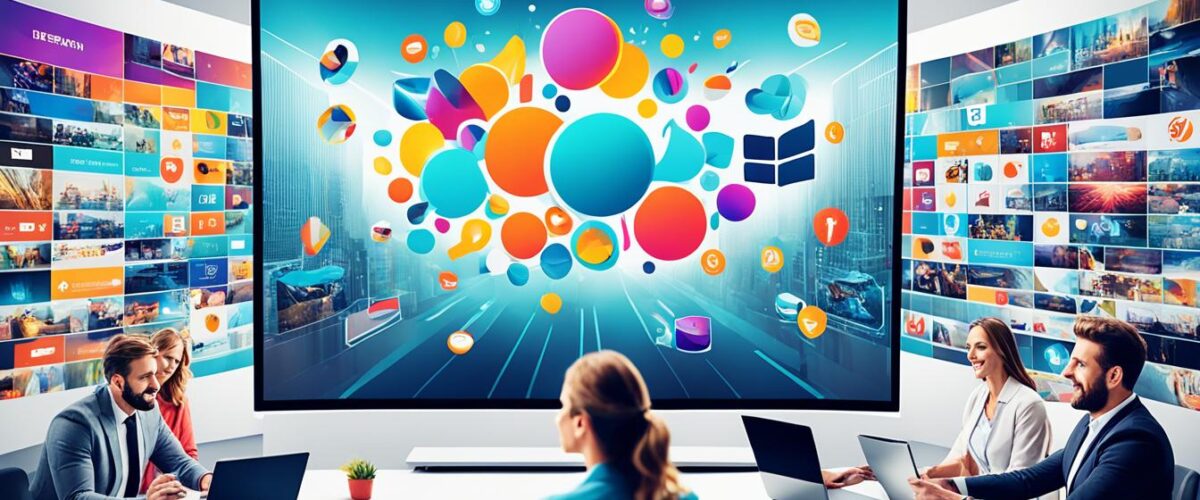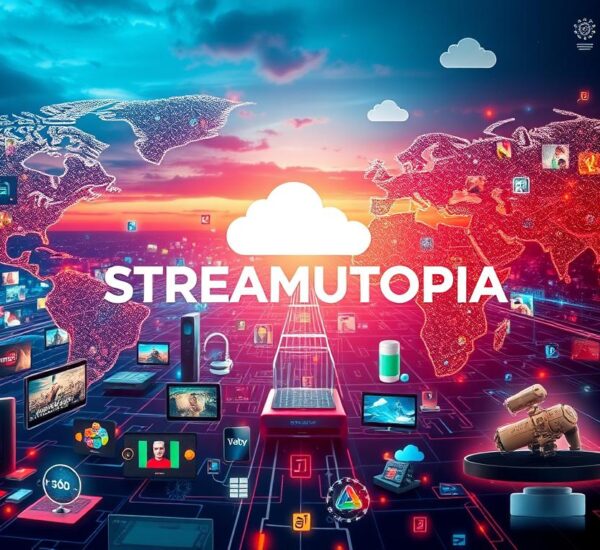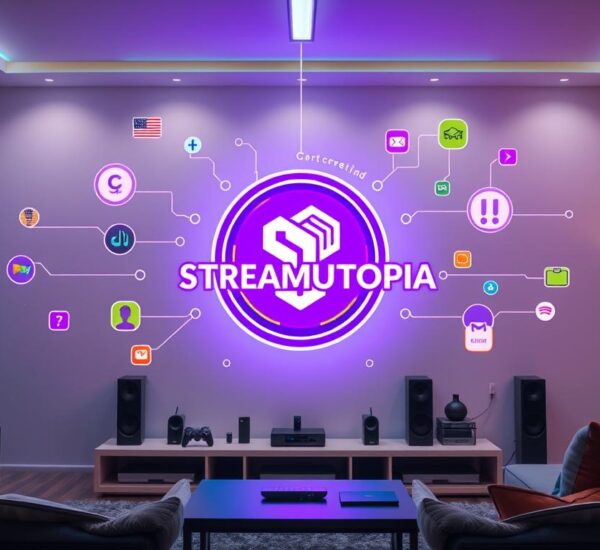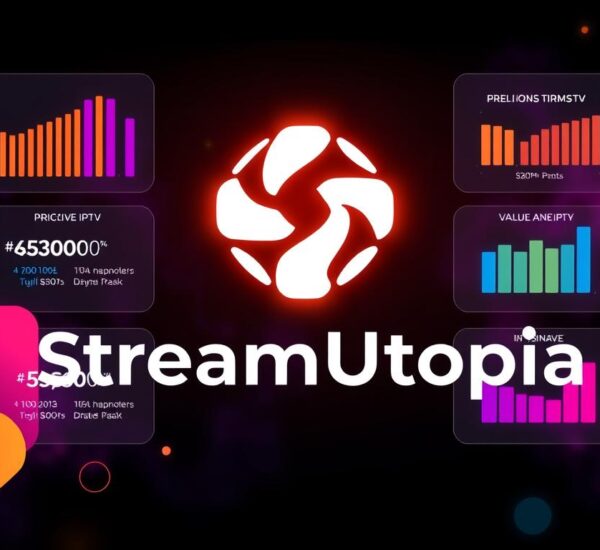Do you know the global IPTV market was worth USD 61.2 billion in 2020? It’s set to grow 13.7% annually from 2021 to 2028. IPTV means Internet Protocol Television.
This technology changes how we watch TV, making it a new, exciting experience. It uses the internet to stream live TV, offer videos on demand, and provide internet TV. We will explain in detail what IPTV is, discuss its basics, market scope, cost versus conventional TV, privacy, what you need to get started, opportunities for developers, and where IPTV is headed in the future.
Key Takeaways:
- IPTV leverages the internet to deliver television programming directly to viewers’ devices.
- The global IPTV market was valued at USD 61.2 billion in 2020 and is expected to grow exponentially.
- IPTV offers a personalized viewing experience with live TV streaming, on-demand video, and internet television.
- IPTV provides cost savings, extensive on-demand content libraries, and multi-device streaming.
- However, IPTV comes with security and privacy considerations that users need to be aware of.
Understanding the Basics of IPTV
IPTV stands for Internet Protocol Television. It uses the Internet Protocol to deliver TV content through a network. Video content is made digital, packed as data packets, and sent over IP networks to devices.
This tech makes it easy for viewers to watch TV when they want. It allows for watching live TV, pausing, and diving into a library of on-demand content.
By turning TV signals into data packets, IPTV ensures high-quality video. It lets people watch smoothly on the internet and other IP networks without interruptions.
Benefits of IPTV
One big plus of IPTV is on-demand content. Viewers can pick what they want to watch, when they want. This beats the old way of sticking to TV schedules.
Not only that, but IPTV also suggests shows based on what you like. This makes sure you always find something interesting to watch.
IPTV is also great for watching TV on different devices. You can use smart TVs, phones, or laptops. This means you can watch your favorite stuff wherever you are.
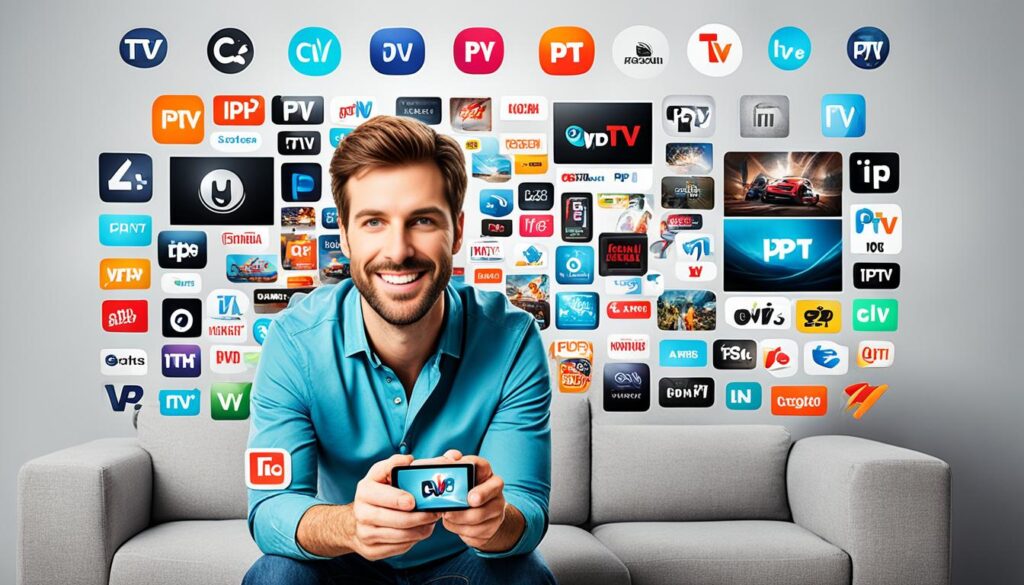
The IPTV market is growing fast. It promises a new way to watch TV, with a personal touch, savings, and a wide range of content.
The Global IPTV Market: Size, Growth, and Key Players
The global IPTV market is growing fast. In 2020, its value reached USD 61.2 billion. And it’s expected to keep growing by 13.7% every year until 2028. This big jump is thanks to more people wanting TV streaming and on-demand videos.
The market is filled with big phone and media companies, along with new startups. They see the big opportunity in IPTV and are offering more. This includes names like AT&T and Deutsche Telekom AG.
They use their skills and money to offer top-notch streaming to the world. Always coming up with new things to make watching TV better and to stay on top in a tough market.

| Year | Market Size (USD Billion) | Growth Rate |
|---|---|---|
| 2020 | 61.2 | – |
| 2021 | 68.9 | 13.7% |
| 2022 | 78.4 | 13.7% |
| 2023 | 89.1 | 13.7% |
| 2024 | 101.2 | 13.7% |
| 2025 | 114.7 | 13.7% |
| 2026 | 129.8 | 13.7% |
| 2027 | 146.8 | 13.7% |
| 2028 | 165.9 | 13.7% |
This table shows how the IPTV market will grow from 2021 to 2028. Each year, it’s expected to increase by 13.7%.
New startups and big players from other fields joining in make the IPTV market even more competitive. There’s a lot of room for companies to offer new streaming services. This opens doors for more and more people to watch TV online.
IPTV vs. Traditional TV: Cost, Features, and Pros/Cons
Looking at your TV choices, it’s good to compare IPTV and traditional TV. This way you can choose well. We’ll talk about their costs, features, and the good and bad parts of each.
Cost Comparison
IPTV is usually cheaper. You pay less each month than with traditional TV services. This is because IPTV uses the internet for its shows and movies. There’s no need for costly cable or satellite tech. So, IPTV can give you better deals.
But, traditional TV can get pricey over time. You have to pay for stuff like renting equipment, setting it up, and special channels. These extras can make traditional TV more costly.
Features Comparison
IPTV has many great features. One cool thing is all the stuff you can watch on demand. They have lots of movies and shows ready for you to pick from.
It also learns what you like to watch. Then, it suggests new things based on your tastes. This way, you always find something interesting to watch.
You can even record shows with IPTV. And you don’t need a physical device to keep them. You can watch your saved shows on any device, which is super convenient.
Plus, IPTV lets you watch on different gadgets. It’s not just for your TV. You can use your phone, tablet, or computer to watch, too.
Pros and Cons
Still, IPTV has some downsides. It needs a good internet connection. If your internet isn’t fast or stable, you might have trouble streaming without interruptions.
Also, you might not get all the local channels with IPTV. Traditional TV usually has more local news and programs. This can be a downside if local news is important to you.
Cost, Features, and Pros/Cons Summary:
| IPTV | Traditional TV | |
|---|---|---|
| Cost | Lower average monthly spending | Potential for higher costs with additional fees |
| Features | Extensive on-demand libraries, personalized content recommendations, cloud DVR storage, multi-device streaming | Local channels, premium channel packages |
| Pros | Cost-effective, personalized recommendations, on-demand content, multi-device streaming | Access to local channels, premium content |
| Cons | Dependent on internet connection quality, limited access to local channels | Potential for higher costs, additional fees |
Choosing between IPTV and traditional TV depends on what you want. Look at what they offer and their good and bad points. Then, pick what’s best for you.
IPTV Security and Privacy Considerations
IPTV makes watching TV easy but can bring security and privacy worries. To keep your online TV experience safe and private, it’s key to know these risks. Then, take steps to protect yourself.
Malware and Viruses
IPTV can expose you to malware and viruses. Bad actors may use weak spots in TV apps to spread harmful software. To stay safe, always update your devices and apps. This makes sure you have the latest security fixes.
DNS Hijacking
DNS hijacking is a real threat in the IPTV world. Hackers can reroute you to harmful websites. Use trusted DNS services and check for odd settings often to avoid this.
Data Tracking and Targeted Advertising
When you watch IPTV, companies may track what you watch and your info for ads. To keep your viewing private, adjust your app’s privacy settings. Also, think about using a VPN to keep your internet use private.
Security Tips and Privacy Settings
Here are some helpful tips for safer IPTV use:
- Use strong, unique passwords and turn on two-factor authentication.
- Keep checking and adjusting your app’s privacy settings for less data collection.
- Be careful with third-party apps; it’s safer to stick with well-known ones from official stores.
- Using a good VPN can make your internet use safer and more private.
With these steps, you can make your IPTV viewing more secure and private.
| Security Risks | Recommendations |
|---|---|
| Malware and Viruses | Keep devices and apps up to date. |
| DNS Hijacking | Use reputable DNS providers and regularly check DNS settings. |
| Data Tracking and Targeted Advertising | Configure privacy settings and use VPN services to encrypt traffic. |
Technical Requirements and Setup for IPTV
Getting started with IPTV is easy with some basic needs and a simple setup. Here’s a quick overview:
1. High-Speed Internet Connection
To watch IPTV without issues, you need a steady and fast internet connection. Aim for at least 10 Mbps speed for good quality. For the best experience, speeds of 25 Mbps or more are ideal.
2. Compatible Devices
IPTV works with many devices, letting you watch on different screens in your home. You can use:
- Smart TVs: Most new smart TVs have IPTV apps or can get them from an app store.
- Streaming Devices: Amazon Fire TV Stick, Roku, Apple TV, and Chromecast make streaming easy.
- Mobile Phones and Tablets: IPTV apps for iOS and Android mean you can watch anywhere.
3. IPTV Subscription or App
To start watching, you must get an IPTV subscription or app from a trusted place. Pick from different subscriptions based on the channels and features you like. Go for a provider that has great content and a reliable service.
Setting up IPTV
Setting up IPTV after meeting the tech needs is simple:
- Sign up for IPTV or download the app you need from the provider’s website or store.
- Connect to the internet with Wi-Fi or Ethernet.
- Open the app and enter your subscription details.
- Choose what to watch from the options available.
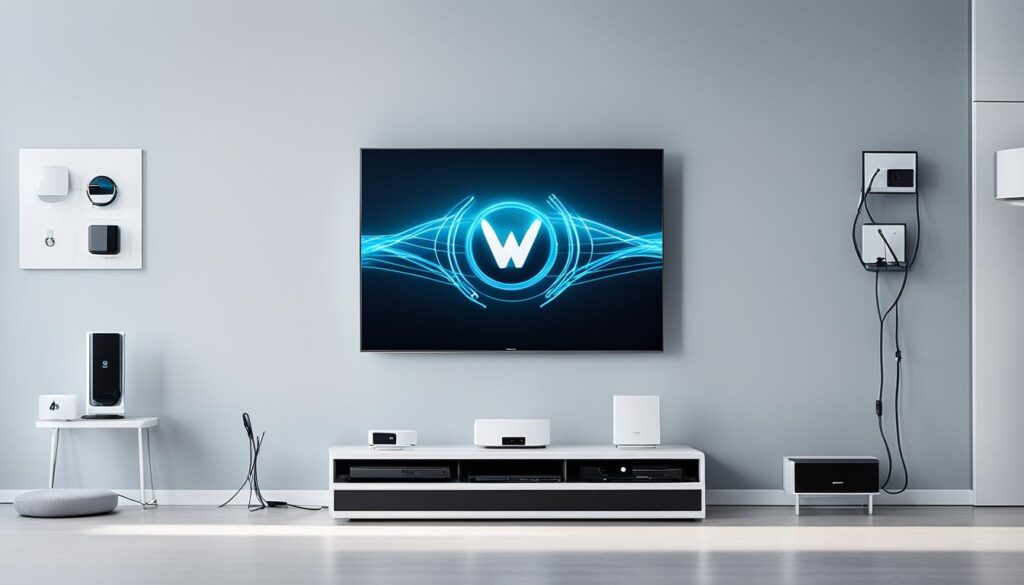
With these steps, you can start enjoying IPTV’s shows, movies, and sports. Make sure your internet is solid and you keep your subscription active for the best viewing.
| Technical Requirements | Setup Process |
|---|---|
| High-speed internet connection (minimum 10 Mbps) | 1. Sign up for IPTV subscription or download provider’s app 2. Connect device to the internet 3. Launch app and log in 4. Browse and select content to stream |
| Compatible devices: Smart TVs, streaming devices, mobile phones, tablets | |
| IPTV subscription or app from a reputable provider |
Opportunities and Challenges for IPTV Developers
The IPTV market is growing fast, offering many chances for developers. They can use their skills to improve IPTV technology. This helps change and better the way IPTV works.
Innovation in Video Compression and Interactive Features
Developers have a big role in making videos look great without using too much data. They find new ways to compress videos. This ensures they still look good even on bigger screens.
They can also add fun features for viewers. Imagine being able to pick what happens next in a show. Or getting recommendations based on what you like to watch. These things make watching TV more interactive and personal.
Integration with Emerging Technologies
New tech like VR, AR, and AI can make IPTV even more exciting. Developers find ways to include these technologies in IPTV. This makes the shows and videos viewers watch more immersive and fun.
Content Distribution and Monetization
How shows and videos get to viewers and how companies make money from them is also important. Developers help with this part too. They make sure the right ads get shown to the right people. They also help keep payments safe online.
Licensing and Copyright Considerations
There are many rules about using and sharing TV shows and movies. Developers need to know these rules well. This protects the people who made the content and the people watching it.
Compatibility, Security, and Privacy Concerns
Making sure IPTV works on all devices and is safe to use is a big task. Developers follow standards and test their work a lot. This way, everyone can enjoy IPTV without problems.
Protecting user information is also very important. Developers work hard to keep the data that viewers share safe. They make sure privacy is always respected.
Even with challenges, the IPTV market is full of chances for developers. By taking on these tasks and always finding new ways, developers help IPTV grow. They make the watching experience better for everyone.
The Future of IPTV: Trends and Predictions
The TV world is changing fast, and IPTV’s future holds a lot of potential. Trends like cord-cutting and new tech advances shape what’s to come for IPTV.
- Cord-cutting: More people are ditching traditional TV for streaming services. This change gives viewers flexibility and saves them money.
- Market growth: The demand for streaming TV is rising, while cable TV is losing ground. This shift will lead to big growth in IPTV.
- Consolidation and partnerships: With IPTV’s fast growth, we’ll see more teamwork and buyouts among big players. They aim to reach more people and offer better services.
- Integration with smart home devices: IPTV will blend well with smart home gadgets. This makes TV watching a part of a broader, connected experience.
- Advances in AI and machine learning: Expect better content suggestions and smoother streaming from AI and machine learning. These techs will also make watching TV online more user-friendly.
- Expansion into new markets: IPTV services will spread their wings, reaching new parts of the world. They’ll adapt to different cultures’ TV-watching habits and preferences.
- Focus on original content: To stand out, IPTV providers will create or buy more unique shows and movies. This move aims to keep people subscribing with tempting, exclusive programming.
- 5G and edge computing: The arrival of 5G and better edge computing will change IPTV. It will make streaming faster, more reliable, and smoother with less lag.
The future for IPTV looks bright. The industry is set for more options, personalized TV, and better connections. As tech and what we like in shows keeps changing, IPTV will keep shaping how we enjoy TV.
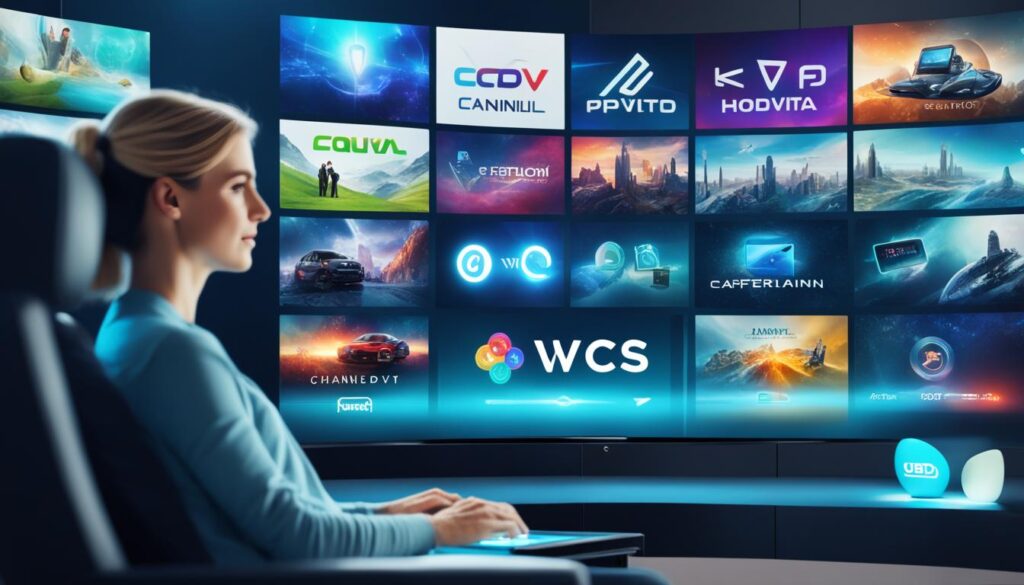
Conclusion
IPTV is changing how we watch TV. It offers a personal, interactive, and cost-saving experience. Viewers can pick their shows and watch them anytime, anywhere. This freedom has brought a change in how we view entertainment.
By using IPTV, creators and providers are stepping into the future of TV. The industry keeps growing, creating chances for new ideas and expansion. Through AI and machine learning, IPTV will soon offer better experiences. This lets creators offer fresh, engaging content to their viewers.
The popularity of streaming is on the rise. IPTV is at the forefront, blending traditional with internet TV. This combo gives viewers a smooth, tailored, and on-demand way to watch. Technologies like 5G and edge computing are pushing IPTV forward, promising even more to come.
So, join the IPTV wave and discover endless entertainment. Whether you’re a viewer wanting more control or a developer looking for new chances, IPTV is the future of TV. It’s your gateway to the next phase in the streaming story.
FAQ
What is IPTV?
How does IPTV work?
What is the market size of IPTV?
How does IPTV compare to traditional TV in terms of cost and features?
What are the security and privacy considerations with IPTV?
What are the technical requirements and setup process for IPTV?
What opportunities and challenges do developers face in the IPTV industry?
What are the future trends and predictions for IPTV?
What are the benefits of IPTV?
